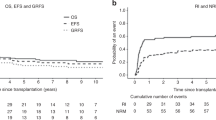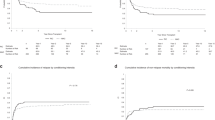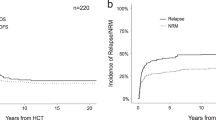Summary:
Intensive therapy and autologous blood and marrow transplantation (ABMT) is an established post-remission treatment for acute myeloid leukemia (AML), although its exact role remains controversial and few data are available regarding longer-term outcomes. We examined the long-term outcome of patients with AML transplanted at a single center using uniform intensive therapy consisting of etoposide, melphalan and TBI. In all, 145 patients with AML underwent ABMT: 117 in first remission, 21 in second remission and seven beyond second remission. EFS and OS were significantly predicted by remission status (P<0.0001). For transplantation in first remission, 8 year EFS and OS were 55% (95% CI, 44–64%) and 62% (95% CI, 50–72%), respectively. By multivariate analysis, only age (P=0.04) and cytogenetic risk group (P=0.006) influenced OS. For patients transplanted in second remission, 8 year EFS and OS were 30% (95% CI, 9–55%) and 36% (95% CI, 13–60%), respectively. No pre-transplant variables significantly predicted outcome. None of the seven patients who underwent ABMT beyond second remission or in early relapse were long-term survivors. ABMT can provide long-term antileukemic control for patients with AML in first remission. For patients in second remission approximately 30% can achieve cure with ABMT, and this option may be preferable to alternate donor allogeneic stem cell transplantation.
This is a preview of subscription content, access via your institution
Access options
Subscribe to this journal
Receive 12 print issues and online access
$259.00 per year
only $21.58 per issue
Buy this article
- Purchase on Springer Link
- Instant access to full article PDF
Prices may be subject to local taxes which are calculated during checkout


Similar content being viewed by others
References
Burnett AK, Tansey P, Watkins R et al. Transplantation of unpurged autologous bone-marrow in acute myeloid leukaemia in first remission. Lancet 1984; 2: 1068–1070.
Stewart P, Buckner CD, Bensinger W et al. Autologous marrow transplantation in patients with acute nonlymphocytic leukemia in first remission. Exp Hematol 1985; 13: 267–272.
Goldstone AH, Anderson CC, Linch DC et al. Autologous bone marrow transplantation following high dose chemotherapy for the treatment of adult patients with acute myeloid leukaemia. Br J Haematol 1986; 64: 529–537.
Carella AM, Gaozza E, Santini G et al. Autologous unpurged bone marrow transplantation for acute non-lymphoblastic leukaemia in first complete remission. Bone Marrow Transplant 1988; 3: 537–541.
Petti MC, Aloe Spiriti MA, Carella AM et al. Intensification in post-remission treatment of adult acute non lymphocytic leukemia. Haematologica 1989; 74: 267–271.
Zittoun RA, Mandelli F, Willemze R et al. Autologous or allogeneic bone marrow transplantation compared with intensive chemotherapy in acute myelogenous leukemia. European Organization for Research and Treatment of Cancer (EORTC) and the Gruppo Italiano Malattie Ematologiche Maligne dell'Adulto (GIMEMA) Leukemia Cooperative Groups. N Engl J Med 1995; 332: 217–223.
Harousseau JL, Cahn JY, Pignon B et al. Comparison of autologous bone marrow transplantation and intensive chemotherapy as postremission therapy in adult acute myeloid leukemia. The Groupe Ouest Est Leucemies Aigues Myeloblastiques (GOELAM). Blood 1997; 90: 2978–2986.
Burnett AK, Goldstone AH, Stevens RM et al. Randomised comparison of addition of autologous bone-marrow transplantation to intensive chemotherapy for acute myeloid leukaemia in first remission: results of MRC AML 10 trial. UK Medical Research Council Adult and Children's Leukaemia Working Parties. Lancet 1998; 351: 700–708.
Cassileth PA, Harrington DP, Appelbaum FR et al. Chemotherapy compared with autologous or allogeneic bone marrow transplantation in the management of acute myeloid leukemia in first remission. N Engl J Med 1998; 339: 1649–1656.
Gorin NC, Labopin M, Fouillard L et al. Retrospective evaluation of autologous bone marrow transplantation vs allogeneic bone marrow transplantation from an HLA identical related donor in acute myelocytic leukemia. A study of the European Cooperative Group for Blood and Marrow Transplantation (EBMT). Bone Marrow Transplant 1996; 18: 111–117.
Ringden O, Labopin M, Gluckman E et al. Donor search or autografting in patients with acute leukaemia who lack an HLA-identical sibling? A matched-pair analysis. Acute Leukaemia Working Party of the European Cooperative Group for Blood and Marrow Transplantation (EBMT) and the International Marrow Unrelated Search and Transplant (IMUST) Study. Bone Marrow Transplant 1997; 19: 963–968.
Lazarus HM, Perez WS, Klein JP et al. Autotransplantation versus HLA-matched unrelated donor transplantation for acute myeloid leukemia (AML): a retrospective comparison from the National Marrow Donor Program, the International Bone Marrow Transplant Registry and the Autologous Blood and Marrow Transplant Registry. Blood 2004; (in press).
Keating A, Crump M . High dose etoposide melphalan, total body irradiation and ABMT for acute myeloid leukemia in first remission. Leukemia 1992; 6 (Suppl. 4): 90–91.
Grimwade D, Walker H, Oliver F et al. The importance of diagnostic cytogenetics on outcome in AML: analysis of 1,612 patients entered into the MRC AML 10 trial. The Medical Research Council Adult and Children's Leukaemia Working Parties. Blood 1998; 92: 2322–2333.
Kovacs MJ, Crump M, Keating A . Outpatient bone marrow harvesting: an update. Bone Marrow Transplant 1995; 15: 125–127.
Appelbaum FR . Who should be transplanted for AML? Leukemia 2001; 15: 680–682.
Rowe JM . Current standard therapy of adult acute myeloid leukemia. Hematology. Washington: American Society of Hematology, 2001, pp 62–68.
Linker CA . Autologous stem cell transplantation for acute myeloid leukemia. Bone Marrow Transplant 2003; 31: 731–738.
Gorin NC . Autologous stem cell transplantation for adult acute leukemia. Curr Opin Oncol 2002; 14: 152–159.
Stripecke R, Levine AM, Pullarkat V et al. Immunotherapy with acute leukemia cells modified into antigen-presenting cells: ex vivo culture and gene transfer methods. Leukemia 2002; 16: 1974–1983.
Stein AS, O'Donnell MR, Slovak ML et al. Interleukin-2 after autologous stem-cell transplantation for adult patients with acute myeloid leukemia in first complete remission. J Clin Oncol 2003; 21: 615–623.
Wheatley K, Burnett AK, Goldstone AH et al. A simple, robust, validated and highly predictive index for the determination of risk-directed therapy in acute myeloid leukaemia derived from the MRC AML 10 trial. United Kingdom Medical Research Council's Adult and Childhood Leukaemia Working Parties. Br J Haematol 1999; 107: 69–79.
Mehta J, Powles R, Sirohi B et al. Impact of cytogenetics on the outcome of autotransplantation for acute myeloid leukemia in first remission: is the benefit of intensive pretransplant therapy limited to patients with good karyotypes? Bone Marrow Transplant 2003; 32: 157–164.
Ferrant A, Labopin M, Frassoni F et al. Karyotype in acute myeloblastic leukemia: prognostic significance for bone marrow transplantation in first remission: a European Group for Blood and Marrow Transplantation study. Acute Leukemia Working Party of the European Group for Blood and Marrow Transplantation (EBMT). Blood 1997; 90: 2931–2938.
Gray R, Wheatley K . How to avoid bias when comparing bone marrow transplantation with chemotherapy. Bone Marrow Transplant 1991; 7: 9–12.
Keating S, Suciu S, de Witte T et al. The stem cell mobilizing capacity of patients with acute myeloid leukemia in complete remission correlates with relapse risk: results of the EORTC-GIMEMA AML-10 trial. Leukemia 2003; 17: 60–67.
Feller N, Schuurhuis GJ, van der Pol MA et al. High percentage of CD34-positive cells in autologous AML peripheral blood stem cell products reflects inadequate in vivo purging and low chemotherapeutic toxicity in a subgroup of patients with poor clinical outcome. Leukemia 2003; 17: 68–75.
Gorin NC, Labopin M, Laporte JP et al. Importance of marrow dose on posttransplant outcome in acute leukemia: models derived from patients autografted with mafosfamide-purged marrow at a single institution. Exp Hematol 1999; 27: 1822–1830.
Yeager AM, Kaizer H, Santos GW et al. Autologous bone marrow transplantation in patients with acute nonlymphocytic leukemia, using ex vivo marrow treatment with 4- hydroperoxycyclophosphamide. N Engl J Med 1986; 315: 141–147.
Linker CA, Damon LE, Ries CA et al. Busulfan plus etoposide as a preparative regimen for autologous bone marrow transplantation for acute myelogenous leukemia: an update. Semin Oncol 1993; 20: 40–48.
Selvaggi KJ, Wilson JW, Mills LE et al. Improved outcome for high-risk acute myeloid leukemia patients using autologous bone marrow transplantation and monoclonal antibody-purged bone marrow. Blood 1994; 83: 1698–1705.
Meloni G, Vignetti M, Avvisati G et al. BAVC regimen and autograft for acute myelogenous leukemia in second complete remission. Bone Marrow Transplant 1996; 18: 693–698.
Tomas F, Gomez-Garcia de Soria V, Lopez-Lorenzo JL et al. Autologous or allogeneic bone marrow transplantation for acute myeloblastic leukemia in second complete remission. Importance of duration of first complete remission in final outcome. Bone Marrow Transplant 1996; 17: 979–984.
Dusenbery KE, Steinbuch M, McGlave PB et al. Autologous bone marrow transplantation in acute myeloid leukemia: the University of Minnesota experience. Int J Radiat Oncol Biol Phys 1996; 36: 335–343.
Mehta J, Powles R, Singhal S et al. Melphalan–total body irradiation and autologous bone marrow transplantation for adult acute leukemia beyond first remission. Bone Marrow Transplant 1996; 18: 119–123.
Ball ED, Wilson J, Phelps V et al. Autologous bone marrow transplantation for acute myeloid leukemia in remission or first relapse using monoclonal antibody-purged marrow: results of phase II studies with long-term follow-up. Bone Marrow Transplant 2000; 25: 823–829.
Linker CA, Damon LE, Ries CA et al. Autologous stem cell transplantation for advanced acute myeloid leukemia. Bone Marrow Transplant 2002; 29: 297–301.
Acknowledgements
AK holds the Gloria and Seymour Epstein Chair in Cell Therapy and Transplantation at University Health Network and the University of Toronto. We thank Qi-Long Yi for his assistance with the statistical analysis of the data.
Author information
Authors and Affiliations
Corresponding author
Rights and permissions
About this article
Cite this article
Mollee, P., Gupta, V., Song, K. et al. Long-term outcome after intensive therapy with etoposide, melphalan, total body irradiation and autotransplant for acute myeloid leukemia. Bone Marrow Transplant 33, 1201–1208 (2004). https://doi.org/10.1038/sj.bmt.1704506
Received:
Accepted:
Published:
Issue Date:
DOI: https://doi.org/10.1038/sj.bmt.1704506
Keywords
This article is cited by
-
High-dose idarubicin plus busulfan as conditioning regimen to autologous stem cell transplantation: Promising post-remission therapy for acute myeloid leukemia in first complete remission?
Medical Oncology (2014)
-
In haematopoietic SCT for acute leukemia TBI impacts on relapse but not survival: results of a multicentre observational study
Bone Marrow Transplantation (2013)
-
Auto-SCT for AML in second remission: CALGB Study 9620
Bone Marrow Transplantation (2009)



